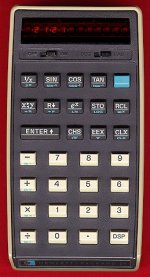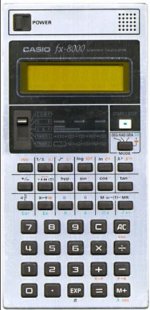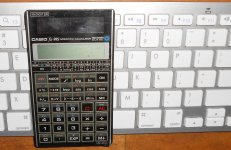I have a Casio FX8000 scientific calc from college days (still in perfect working order) and like any other calculator of its era it gives answers I can relate too. Eighteen months back I bought a new Casio (FX991ES) and found the notation of inputting figures totally different. I'm sure you know where this is leading...
3+2*4=20 on the old Casio.
3+2*4=11 on the new.
Having got used to rapidly punching numbers in, for example db ratios etc over the last 30 years, I find the "new" way totally confusing... to the point that I don't use it much.
3+2*4=20 on the old Casio.
3+2*4=11 on the new.
Having got used to rapidly punching numbers in, for example db ratios etc over the last 30 years, I find the "new" way totally confusing... to the point that I don't use it much.
Mooly,
I can relate, the difference from what you learn in grammar school and learning to use reverse Polish notation. You can and should be able to arrive at the same final answer you just have to understand the different way to enter the data. Somewhat like the difference in the sentence structure when you look at English and then have to think to me backwards when saying something in Spanish.
I can relate, the difference from what you learn in grammar school and learning to use reverse Polish notation. You can and should be able to arrive at the same final answer you just have to understand the different way to enter the data. Somewhat like the difference in the sentence structure when you look at English and then have to think to me backwards when saying something in Spanish.
3+2*4=20 on the old Casio.
3+2*4=11 on the new.
That's strange Mooly.
With my first TI scientific calculator some 35 years ago (that I used it for more than 15 years), when no parenthesis or brackets were keyed-in, multiplication and division took precedence in execution over addition and subtruction.
I remember that in TI excellent user manual, the order of arithmetic operations was mentioned as conforming to "Polish notation" order.
George
>Edit: After reading Kindhornman's post, I have to question my memory retriaval capabilities. Was it "Polish notation" or "Inverse Polish notation" mentioned in that manual?
Last edited:
Scott W.,
Could you see some relationship to this mesoscopic physics and a new way of looking at the noise generation in audio circuits that is not covered by classical electronics that would perhaps help explain some unknown functions that we are always looking to solve? What I guess I am asking is will this perhaps create new understanding beyond the measurements that we all seem to agree does not explain all the things we hear as related to what we measure with standard distortion measurements? Do you see this as creating a new form of distortion measurement at some point in the future?
Could you see some relationship to this mesoscopic physics and a new way of looking at the noise generation in audio circuits that is not covered by classical electronics that would perhaps help explain some unknown functions that we are always looking to solve? What I guess I am asking is will this perhaps create new understanding beyond the measurements that we all seem to agree does not explain all the things we hear as related to what we measure with standard distortion measurements? Do you see this as creating a new form of distortion measurement at some point in the future?
Scott W.,
Could you see some relationship to this mesoscopic physics and a new way of looking at the noise generation in audio circuits that is not covered by classical electronics that would perhaps help explain some unknown functions that we are always looking to solve?
No not really, our audio circuits are macroscopic by any definition of the term. These exotic diciplines mainly fuel the BS'ers with speculative misdirections and buzz words to dupe the suckers.
I have a Casio FX8000 scientific calc from college days (still in perfect working order) and like any other calculator of its era it gives answers I can relate too. Eighteen months back I bought a new Casio (FX991ES) and found the notation of inputting figures totally different. I'm sure you know where this is leading...
3+2*4=20 on the old Casio.
3+2*4=11 on the new.
Having got used to rapidly punching numbers in, for example db ratios etc over the last 30 years, I find the "new" way totally confusing... to the point that I don't use it much.
Casio FX-451 scientific calculator here, circa 1979, solar cells so no batteries to run out.
Perfect, includes lots of hex, octal and other programmer-related function.
jan
>Edit: After reading Kindhornman's post, I have to question my memory retriaval capabilities. Was it "Polish notation" or "Inverse Polish notation" mentioned in that manual?
RPN - reverse polish notation
As Lazarus Long said "Anyone who cannot cope with mathematics is not fully human. At best he is a tolerable subhuman who has learned to wear shoes, bathe and not make messes in the house".
jan
Last edited:
I think the first time I saw reverse Polish notation was on my brothers HP41VC calculator with removable cards and the little printer you could add along side it. I know he still has that and it was circa late 70's or early 1980's. I had him doing work on elliptical waveguides back when I had my first desktop Compac computer, 20mb hard drive and all.....
solar cells so no batteries to run out.
Standard in my pocket since ~1981, even operates by the light of a hotel room bedside lamp.
Been meaning to glue that loose edge back on for 2.5 decades.

(oh dear, fraid I have a calculator buying addiction, including programmable ones that do simulations. + miniature keyboards)
Attachments
Last edited:
My first and, I think, only "physical" calculator (that is, excluding the various nice calculators that come with every computer OS, Linux has some nice ones, Win7 finally shipped with a decent calculator) was a HP21. Graduation present from my father when I completed high school and was accepted into university.

I think it has a 4-register stack. The batteries died years ago, and I have never been able to get it to turn on since, either with DIY new batteries (I think I shoved some NiCads into the plastic battery cartridge) or the original wall wart. Even though it doesn't work, you can have it when you pry it from my cold, dead hands. I guess I should take it apart some day and see if I can revive it; it really was a nice RPN calculator.

I think it has a 4-register stack. The batteries died years ago, and I have never been able to get it to turn on since, either with DIY new batteries (I think I shoved some NiCads into the plastic battery cartridge) or the original wall wart. Even though it doesn't work, you can have it when you pry it from my cold, dead hands. I guess I should take it apart some day and see if I can revive it; it really was a nice RPN calculator.
If you understand the math it doesn't really matter what sequence of keystrokes you use to enter an equation, but I will say that using HP RPN calculators prepared my mind for Intel assembly language programming. Especially 80x87 floating point. I'm not sure if that is a good thing or a bad thing.
The HP25 was my first. It had this tiny program memory. I didn't do anything but program for a few weeks, and figured out how to pack primes into strings that the program unpacked, in order to do a faster factorization programMy first and, I think, only "physical" calculator (that is, excluding the various nice calculators that come with every computer OS, Linux has some nice ones, Win7 finally shipped with a decent calculator) was a HP21. Graduation present from my father when I completed high school and was accepted into university.
View attachment 364031
I think it has a 4-register stack. The batteries died years ago, and I have never been able to get it to turn on since, either with DIY new batteries (I think I shoved some NiCads into the plastic battery cartridge) or the original wall wart. Even though it doesn't work, you can have it when you pry it from my cold, dead hands. I guess I should take it apart some day and see if I can revive it; it really was a nice RPN calculator.
A mentor at UCLA however got completely addicted to his HP-65, which had the little magnetic strip memories, and thereafter to the slightly more advanced HP-67. He almost stopped doing anything else for about two years, and if he hadn't had tenure and an indulgent chairman he'd have been fired. He did optical design, and constantly justified the programming based on how much labor it would be saving him
He eventually did get a less accommodating Chair and migrated to UC Santa Cruz, and designed some outstanding cameras and spectrographs for the Keck telescopes, among others --- designs that were considered "impossible".
Whereas for me the fascination of what was possible, the sense of having complete mastery over a small, well-defined and self contained world, was very addictive. So I understand the headspace that your mentor got himself into ...After a while I realized that I didn't want to become a programmer, as so many of my friends tended to become. I later got the family business to buy a Compaq "luggable" and started programming in BasicAfter writing a few useful programs I once again realized that I didn't want to become a programmer.
Can't do that sort of thing anymore - head's said, enough is enough! - now I've just got to let it all hang out ...
Every good programmer (and no, I'm not one either) knows that it is better to spend two weeks writing a program to do something, than to spend two hours doing that thing. Or as Larry Wall said of Laziness (the first great virtue of a programmer): it "...makes you go to great effort to reduce overall energy expenditure."
- Status
- Not open for further replies.
- Home
- Member Areas
- The Lounge
- John Curl's Blowtorch preamplifier part II

